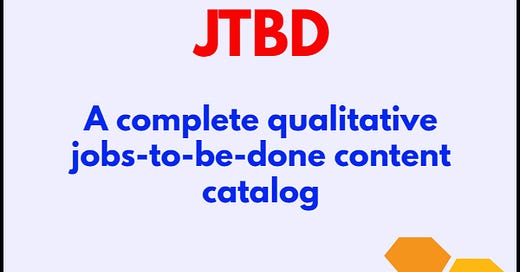From Planning to Satisfaction: How Jobs-to-be-Done Informs the Entire Customer Purchase Journey
Explore how Jobs-to-be-Done can help you design a customer purchase journey that addresses the customers' needs and desires at each stage of the process, from planning to satisfaction
In reality, there are very few people truly focused on innovation. To most of us, it’s just a word. We’re not designing the next Facebook, or the next Internet. We’re dealing with the day-to-day realities of what we’ve been tasked with building, selling, supporting, etc. In fact, most of the money invested today is in the customer experience area. So, let’s make sure we take advantage of that!
FYI: There’s a Freebie somewhere in this post
I’m going to begin by mentioning something you all know…senior executives come up with ideas and the push them down to be executed, and sometimes validated. Typically, they don’t like to be challenged because they are leading the organization and the HIPPO wins. Your ideas mean very little to them, no matter how furiously they nod while you’re presenting them. So, I’d like to arm with a little more data the next time, and to do that you’re going to need the foundation of a solid model.
The Consulting Experience
Unless you’re in smaller companies you’ve probably been near a customer journey mapping exercise. Not too long ago, I was on a video conference with my marketing colleagues and a representatives from a very well-known strategy consulting firm. They were pitching a customer journey mapping engagement, but this time it would be different. There would be this simple question asked at each stage so instead of a single number describing overall satisfaction, they would have a single number at each stage of each journey.
I just about fell out of my chair when someone said…
“I’ve been here for about 5 years and during that time we’ve hired 7 different firms to do the exact same thing (sans the number). Every single time nothing was done and all we have to show for it are some low fidelity journey maps and a PowerPoint deck. How are you going to assure me that this time will be different.”
He said the quiet part out loud and you could see it in the faces of the consultants on the call. They had no answer.
This number I was referring to is the joke of the consulting industry. Everyone fell for it, and careers have been made from it. I don’t recommend mocking it, though! 🤣 What you do want is a high-fidelity model of a customer journey and you want a comprehensive set of definitive success measures that can help you understand your market in ways that will help you to get to personalization much more effectively than purchasing some backward-looking technology that everyone else has access to… and doesn’t know anything about customer needs.
The Buyer Experience?
At this point I’m going to highly recommend you never use the term Jobs-to-be-Done with one of your senior leaders. Use language you all understand, and use on a daily basis. Heck, use their language. Don’t talk about Consumption Chain Jobs because they have no clue what that means, and they do not care about your language. If you’re talking about consumers purchasing something, call it the Buyer Journey, Purchase Journey or whatever is commonly used in your organization. Make your life easier.
But still use the Jobs-to-be-Done method to generate detailed, compelling, and forward-looking data that either validates, or invalidates their assumptions.
Don’t tell them they’re wrong, let them discover the better way! Let them own the differentiated insights you give them and don’t throw them under the bus with your colleagues in advance. Make this a dirty little secret only you and the ultimate champion know.
Okay, enough preaching. This won’t work in every situation 😜
I’m going to give you a head start on your research by providing you (the first 50 of you) with a universal catalog of qualitative research material at no cost. This isn’t going to look like the pretty deliverables you see from some firms. This is the foundation of what ultimately drives those deliverables (actually, most of them have little foundation). It sets you up to get surveys in the field faster so time-to-value is shorter. This is what 3 months of deep research with a team could look like…if they were really, really good.
I’ve broken down the core job (which in this case is not really a core job) into 9 phases. Each phase has 4 or 5 steps (or capabilities) that a consumer must accomplish to get the overall job done successfully. There are a lot of steps!
I’ve provided 10 customer success statements for each of those steps. Again, that’s a lot for a survey. But, the goal is to give you the option of scoping your effort, so this will allow you to reduce the set down where it makes sense instead of worrying that you (or your consulting firm) has missed something.
The customer success statements are nothing more than a statement. They are not metrics, they do not have components added on that will make stakeholders squirm in their chairs, or bore respondents to tears. It’s just plain ole’ English like most of us speak and write. We’re not robots and I would contend that the data you reap will be so much better than traditional market research that it really doesn’t matter if you hear people talking about all the testing they’ve done…so have the traditional market researchers and we know where that got us!
So once again, here’s a free catalog to help you with one of the 15 consumption chain jobs 🤣 and please note…THIS IS A UNIVERSAL CATALOG. If you need something more focused then please reach out (there is a way to do that in the catalog) and ask for help.






